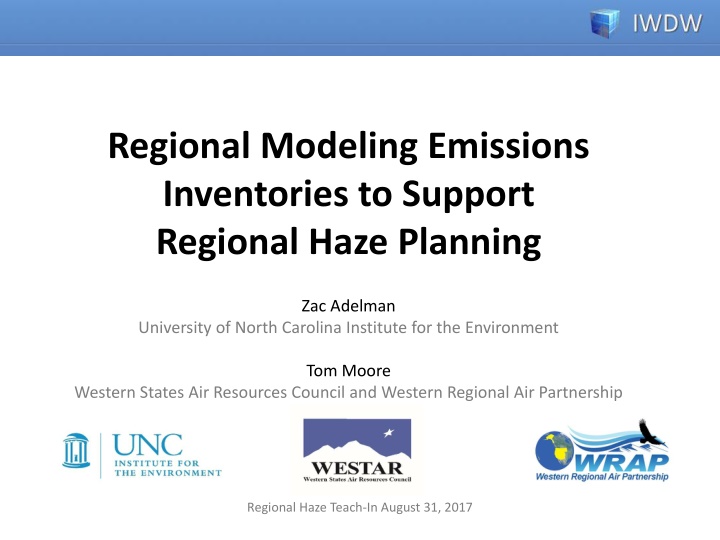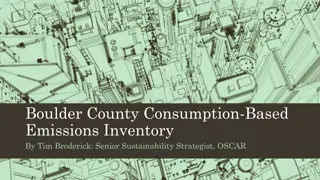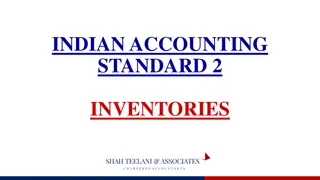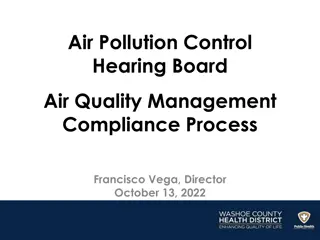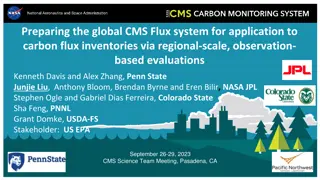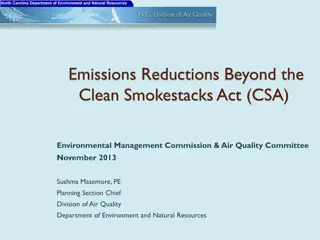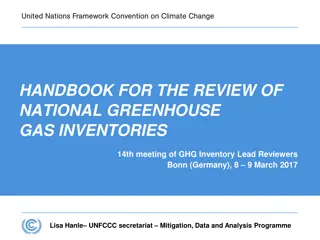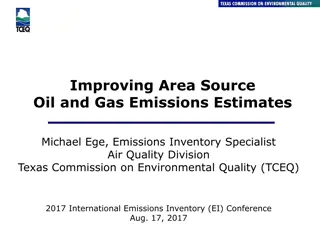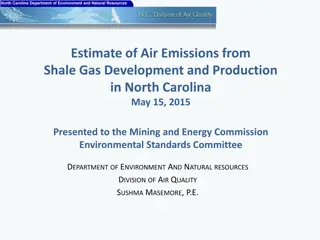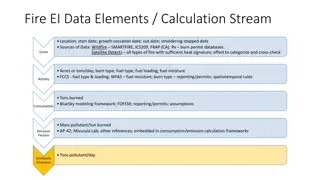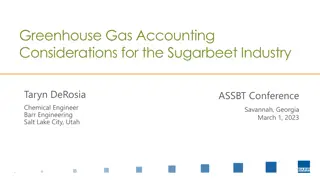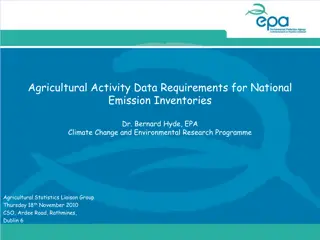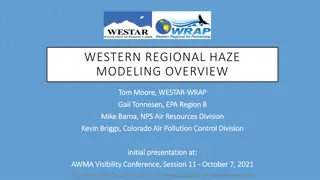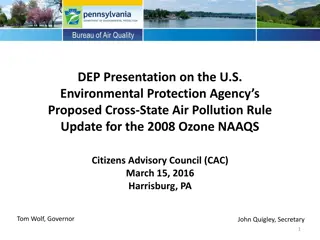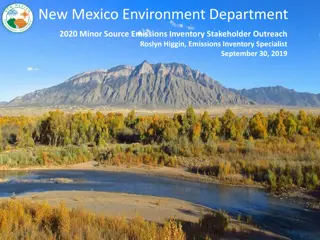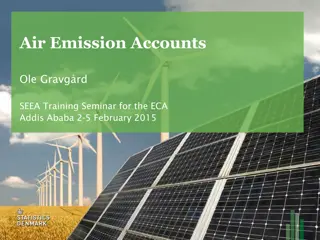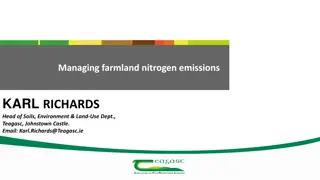Regional Modeling Emissions Inventories for Air Quality Planning
Emissions inventories are crucial for assessing air pollutant sources, trends, and impacts. Learn about the importance, methods, and software used in emissions modeling for regional haze planning.
Download Presentation

Please find below an Image/Link to download the presentation.
The content on the website is provided AS IS for your information and personal use only. It may not be sold, licensed, or shared on other websites without obtaining consent from the author.If you encounter any issues during the download, it is possible that the publisher has removed the file from their server.
You are allowed to download the files provided on this website for personal or commercial use, subject to the condition that they are used lawfully. All files are the property of their respective owners.
The content on the website is provided AS IS for your information and personal use only. It may not be sold, licensed, or shared on other websites without obtaining consent from the author.
E N D
Presentation Transcript
Regional Modeling Emissions Inventories to Support Regional Haze Planning Zac Adelman University of North Carolina Institute for the Environment Tom Moore Western States Air Resources Council and Western Regional Air Partnership Regional Haze Teach-In August 31, 2017
Emissions Inventories: What and Why? What are Emissions Inventories? Current comprehensive listing by sources of air pollutant emissions in a geographical area during a specific time period The basis for numerous efforts including trends analysis, regional, and local scale air quality modeling/planning, regulatory impact assessments, and human exposure modeling Why do we have Emissions Inventories? Section 110(a)(2)(F) of CAA: Requiring SIPs to provide for the reporting of criteria air pollutants Section 169(a): Authority for emission inventories to be required in SIPs developed to protect visibility in Class I federal areas Section 172(c)(3): Discretionary authority to require other emissions data 2
Emissions Inventories: What and Why? Bottom-up inventories are based on a basic parameterization of emissions fluxes: E = A x EF EF relates the quantity of a pollutant released into the atmosphere with the activity that releases it Equation becomes more complex when A and EF vary under different conditions (space, time, technology differences, control programs ) Both A and EF can be parameterized as process- based models E = Emissions (e.g. tons/year) A = Activity (e.g. # emitting process/year) EF = Emissions Factor ( e.g. tons/emitting process) 3
Emissions Modeling Emissions Models are software that estimate emissions processes ( process-based ) MOVES (onroad mobile) MEGAN and BEIS (biogenics) Emissions Processors are software that convert inventories to the terms/formats required by air quality models SMOKE Assign emissions inventory data to grid cells for photochemical grid modeling, e.g., 4km, 12km, and 36km Apply chemical profiles, e.g., total VOC mass to individual species Estimate hourly emissions rates from annual or seasonal inventories 4
Emissions Modeling How is Emissions Inventory Processing done? Emissions inventories are generally annual, county totals for criteria pollutants Regional air quality models and dispersion models used for attainment and maintenance demonstrations have prescriptive formats for input emissions (daily or hourly, uniform spatial grids, detailed chemistry) SMOKE parallel sparse matrix emissions processing paradigm 5
Emissions Inventories and SIP Modeling EPA MJO/S/L/T Inventory Planning Develop Inventory Forecast Emissions NEI EPA National Emissions Inventory (NEI) SIP Planning Inventory (e.g., NAA progress) SIP Modeling Inventory (e.g., attainment demo) Emissions Modeling NO Base Air Quality Future Air Quality Projection/Future-year Inventory Estimate of future emissions with growth and controls For RH, must consider all reasonable controls Modeling is done by EPA, FLMs, MJOs, S/L/Ts Configuration of modeling platforms are specified in advance and vary depending on the modeling group Attainment Test NAAQS Met? YES SIP 6
Types of Emissions Data Emissions data Inventories Natural source data Ancillary Data (spatial/chemical/temporal/codes) Source types Stationary point and area (a.k.a., non-point) sources Mobile on-road/off-network sources Off-road mobile sources Biogenic sources Event sources (i.e. wildfires or emergency releases) Meteorology and Landuse Impact Emissions Examples: Temperatures impact energy use, wind and moisture impact windblown dust and fires Landuse/Landcover/change determines location of sources 7
How Complete are Emissions Inventories? 2014 NEI v1 - contributions of S/L/T agency data to total emissions for each major data category. https://www.epa.gov/sites/production/files/2016-12/documents/nei2014v1_tsd.pdf States have different mixes of anthropogenic and natural sources States have different regulatory programs for anthro sources affecting the emission rates and tracking of inventory data Non-point anthro and/or natural source data reporting by state varies quite a bit, and gap- filling by EPA may or may not be representative for air quality planning For the 2014 NEI v1, Figures 2-1 and 2.2 on the following slides show the proportion of Criteria Air Pollutant emissions from various data sources in the NEI for point and nonpoint sources, and mobile sources, respectively. For regional haze planning, selected emissions categories can also be extracted from the NEI dataset Then changes can be made to the data and/or base year represented Likely necessary for regionally representative data as well as for robust projections 8
How Complete are Emissions Inventories? 2014 NEIv1 proportion of CAP emissions from various data sources for point and nonpoint sources. 9
How Complete are Emissions Inventories? 2014 NEI v1 - proportion of CAP emissions from various data sources for mobile sources. 10
Sources of Emissions Data NEI 2014 v1 - Triennial schedule, 2-3 year lag; national scale, directed by EPA - Usually at least 2 versions - Each version requires QA for planning purposes and then emissions / air quality modeling The Intermountain West Data Warehouse (IWDW) has been fully supported by multiple federal and state agencies, with assistance from WESTAR and WRAP, since its creation through the 3SAQS Pilot Study. - The IWDW provides air quality data, emissions modeling data, photochemical grid modeling products, and analysis tools to support various air quality applications - Datasets can be customized for regional haze analysis and planning studies at various scales, including projection of future year emissions, along with complete documentation. 11
Customizable Source of Emissions Data Regional Haze Teach-In August 31, 2017
Projection Year data for Planning Regional Haze Teach-In August 31, 2017
How to Assess & Evaluate Emissions Data Regional emissions data are impossible to measure Exceptions are stack tests: Continuous Emissions Monitors (CEMs) Evaluation of inventories are done by proxy Comparison of past or similar inventories Analysis by experts Data sharing and graphical summaries Air quality model evaluation 14
Inventories for Regional Haze Planning Key pollutants for regional haze Primary & secondary PM precursors: PM, NH3, SO2, and NOx CO and VOCs less important Air toxics not important at all Primary fine PM (PM2.5) is speciated to SO4, NO3, NH4, EC, OC, soil, other Source-based profiles from EPA SPECIATE database S/L/Ts can provide profiles for inclusion in SPECIATE Assignment of profiles to sources based on expert judgement, primarily by EPA 15
Strengths/Weaknesses of Emissions Modeling Emissions modeling has evolved towards process-based models and disaggregating the inventories to more detailed sectors Can lose connection to native EIs provided by different air quality mgmt. agencies, which are based on regulations and permits Allows for more control over how sources are simulated, evaluated, substituted, and projected The trade off for more detail is more complexity in the modeling process Areas needing improvement Comparable EI inputs from outside the U.S. Mobile sources Nonpoint stationary Natural / Quasi-natural: fire and dust emissions of all types, ammonia, biogenics Chemical speciation Consistent/systematic QA/QC of emissions and modeling 16
